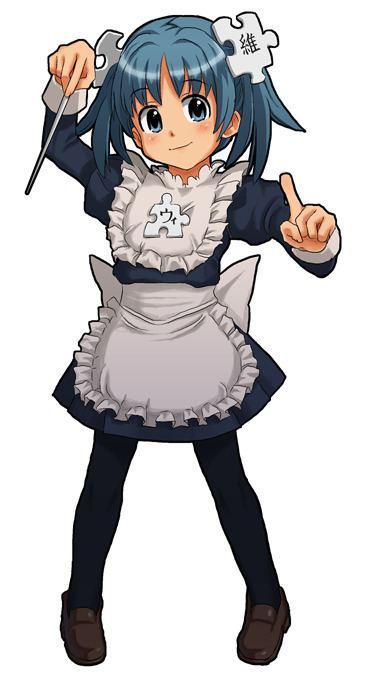 | ||
Moe anthropomorphism (萌え擬人化, moe gijinka) is a form of anthropomorphism where moe qualities are given to non-human beings, objects, concepts, or phenomena. In addition to moe features, moe anthropomorphisms are also characterized by their accessories, which serve to emphasize their original forms before anthropomorphosis. The characters here, usually in a kind of cosplay, are drawn to represent an inanimate object or popular consumer product. Part of the humor of this personification comes from the personality ascribed to the character (often satirical) and the sheer arbitrariness of characterizing a variety of machines, objects, and even physical places as cute.
Contents
This form of anthropomorphism is very common in otaku subcultures. With the exception of kemonomimi (which are human-like characters that have animal features), many moe anthropomorphizations started as dōjin efforts. At first many were the results of discussions on Japanese internet forums such as 2channel or Futaba Channel. The trend spread out of dōjin circles as commercial anime and manga also prominently feature characters who are personifications of inanimate objects.
Animals
Kemonomimi, literally meaning "animal ears", is the concept of drawing animals as bishōjo or bishōnen, or having such characters wear animal accessories such as ears or tails. Catgirls and catboys are the most prolific in this category, although bunnygirls, foxgirls, and dog girls are also common. Kemonomimi characters typically appear human except for added animal-like qualities. The concept has some connection to furry fandom.
Computers
Although Chobits (2001) and Toy's iMac Girl (1998) came first, the meme of turning computer-related phenomena into moe subjects did not start until Shiitake-chan (しいたけちゃん), the anthropomorphization of Internet Explorer's Stop button. The idea of Shiitake-chan came in 2001 on 2channel, starting with a poster who claims he saw the Stop button as a shiitake. When Microsoft released Windows 7 in Japan, they included a theme pack centered around a personification of the OS named "Nanami Madobe" with voice samples from Nana Mizuki. Microsoft used another personification involving two girls named "Yū Madobe" and "Ai Madobe" to promote Windows 8 in Japan. As part of the market launch, a Facebook draw of 8 followers took place when follower count reaches 80001; and total Twitter follower count for Yū and Ai reach 8001, where winners receive Madobe Yū and Ai-themed prizes.
Since the creation of the OS-tans, other software and websites have been anthropomorphized as well. For example, the free encyclopedia Wikipedia has its own "Wikipe-tan", while Mozilla applications have their own set of "Moezilla". Chinese netizens have created a "Green Dam Girl" to parody China's content-control software Green Dam Youth Escort. In 2010, Taiwanese illustrator known as "shinia" on Pixiv created a personification of Microsoft Silverlight named Hikaru Aizawa, who is officially promoted by Microsoft Taiwan. In 2013, Microsoft Singapore introduced Inori Aizawa, a mascot for Internet Explorer.
The manga and anime series Aoi Sekai no Chūshin de features characters who are personifications of computer games. Video games with characters based on them include Sonic the Hedgehog, Super Mario and Tetris. The anime series Hi sCoool! SeHa Girl features personifications of video game hardware by Sega.
Law and politics
Elements of the Japanese constitution have been anthropomorphised into moe girls, such as Article 9, which prevents Japan from waging war, "is portrayed as a peace-loving girl."
In 2010, users from the Breaking News board on 2channel created Hinomoto Oniko as an anthropomorphism of the commonly used Chinese ethnic slur used against Japanese, Riben guizi (日本鬼子), literally meaning "Japanese devils". The character was made by the 2channel community in response to the growing anti-Japanese sentiment amongst Chinese netizens online, and has since become an Internet meme within Japanese imageboards and forums. In Japanese, the kun'yomi reading of the kanji which make up the racial slur can be interpreted as a female personal name, and so the character is depicted as a young female wearing a traditional Japanese kimono, along with devil horns and a katana.
In 2015, Internet users created "ISIS-chan", a moe anthropomorphized character of the jihadist group Islamic State of Iraq and Syria (ISIS). Images of her have been used by Anonymous to dilute the Islamic State's online propaganda.
Others
Other things have also been given moe characteristics:
